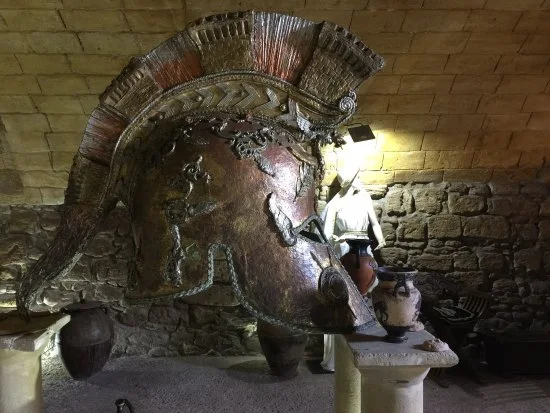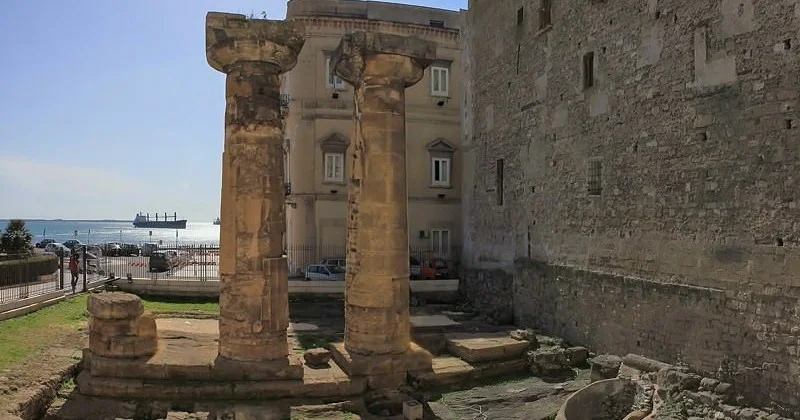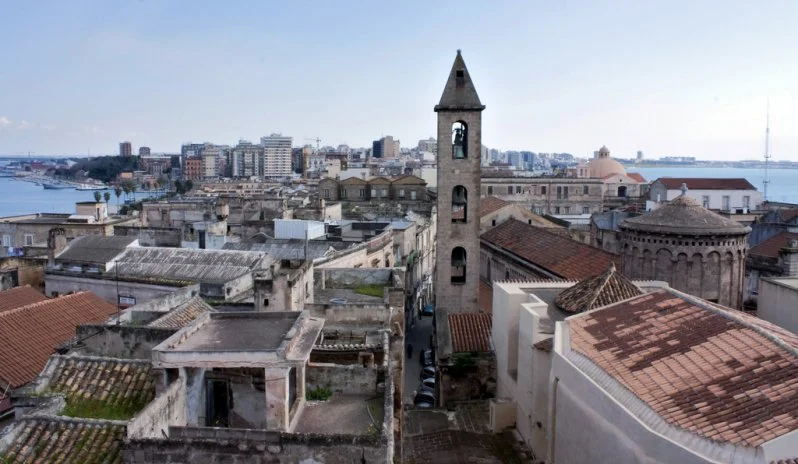1. Aragonese Castle (Castello Aragonese)
Undoubtedly, one of the oldest and most grandiose Sights of Taranto, and indeed of all Italy, is the Aragonese Castle located on the island of Borgo Antico, which is located at the entrance to the bay that surrounds the city.
Located on the seashore to guard the city's navigable canal, it was built on the remains of an earlier Norman structure, which itself was based on a citadel built by the Byzantines to defend against the Saracens.
The main walls and towers that have survived to this day, however, were built at the end of the 14th century by Ferdinand II of Aragon. The entrance to the castle is preceded by an amazingly well-preserved medieval drawbridge, passing it you can walk along the battlements and towers and from them you can look at the sea and the island of St. Peter. The attraction of the Aragonese castle is the Chapel of St. Leonardo, which is located within the walls of the castle and stands out among the gray walls with amazingly beautiful decoration.
 |
| Aragonese Castle - Taranto, Italy |
2. Taranto Cathedral
This Byzantine structure was originally erected in the 10th century and then rebuilt and reconstructed in the 11th century with the addition of a basilica. The Taranto Cathedral is one of the oldest Romanesque buildings in Puglia and is dedicated to San Cataldo, an Irish monk who lived and was buried here in the 7th century. The cathedral is located in the center of Borgo Antico, which can be easily reached on foot and is a great attraction to visit during a tour of the old town.
The front façade of the cathedral has several decorative marble statues and pediments, and the coat of arms of Taranto can be seen above the huge doorway. Inside the cathedral, Byzantine influences are evident, but most noticeable in the original mosaic floor tiles.
 |
| Taranto Cathedral, Italy |
3. Spartan Museum Taranto
In ancient times, the legendary Spartans actually had a colony in what is now Taranto. Both the history and the bygone era are still preserved and well represented in the Spartan Museum. This museum is located on Corso Vittorio Emanuele II, but the actual museum and exhibits are underground. You can walk past an unassuming museum building without noticing it, look for a red sign above the door. Inside the museum you will find old chambers that were built thousands of years ago by experienced Spartan craftsmen. Here you can learn about the history of the Spartans in the region and see an interesting collection of artifacts and recreated armor.
The Spartan Underground Museum is a unique complex in the entire historical and artistic Apulian panorama, as it bears witness to different eras and historical periods, stretching from the founding of Taranto by the Spartans in 706 BC to the 17th century. In 2007, the museum received the title of "cultural monument of national importance".
 |
Spartan Museum Taranto |
4. National Archaeological Museum of Taranto
The National Archaeological Museum of Taranto is one of the most famous archaeological museums in Italy, and its amazing collection can amaze any traveler. The museum is located in the building of the former monastery of San Pasquale di Babylon, near the Public Garden in Piazza Garibaldi .
The collection of the museum has more than 200 thousand artifacts, from prehistoric times to the Middle Ages - a tour of the museum follows the chronological order of the collection , starting from the 5th millennium BC. The first exhibition focuses on the indigenous population of the Yapigans and the Aegean world prior to colonization in the Gulf of Taranto, with a particularly well-presented everyday objects associated with worship and funeral rituals in Greek Taranto .
The changes brought about by the arrival of the Romans are evident in a series of sculptures and terracotta figurines, as well as crockery and gold objects. Don't miss the incredible Ori di Taranto ( Taranto's Golden Treasure), a stunning collection of gold pieces from the Hellenic era, as well as a marble bust of the legendary Hercules, exquisite bronze and gold jewelry, Renaissance oil paintings and beautiful mosaic floor tiles.
 |
| National Archaeological Museum of Taranto |
5. Temple of Poseidon (Tempio di Poseidon)
As mentioned earlier, Taranto was inhabited by various ancient civilizations, including the Spartans and Greeks. Remnants of these historical eras can still be seen throughout the city, and the most notable landmark from this period is the Temple of Poseidon or the Doric Temple.
Located on the historic island of Borgo Antico, the temple is within easy reach of major attractions, including the Aragonese Castle. This temple dates back to the 6th century BC. and is dedicated to the god of the seas Poseidon. Today, despite the fact that you can see only two of the many original columns of the temple, which have stood for thousands of years, you will still feel the atmosphere of the deep antiquity of this place.
 |
| Temple of Poseidon, Taranto |
6. State Palace (Palazzo del Governo)
In a large semicircular square in the new part of Taranto, not far from Borgo Antico, is another tourist attraction in Taranto - the State Palace. It was built on the ruins of the specially destroyed theater of the Politeama Alhambra, and was inaugurated on September 7, 1934 personally by Benito Mussolini.
 |
| Palazzo del Governo Taranto, Italy |
7. Monument to Italian Sailors (Monumento al Marinaio)
The Monument to Italian Sailors of Taranto is dedicated to the brave sailors of the Italian Navy and is made of pure bronze. This monument, built in 1974 by sculptor Vittorio Do Cobertaldo, also pays tribute to the Battle of Taranto, in which the Italian Navy clashed with the British fleet during World War II. This monument is an important work of art and one of the main icons of the city.
 |
| Monument to Italian Sailors - Taranto |
8. Borgo Antico
Borgo Antico is the historic center of Taranto located on an island between two headlands of the mainland. Most of the city's historic landmarks are located here, including the Aragonese Castle and the Temple of Poseidon.
It is worth taking a stroll along the charming medieval alleys outside the excursion and admiring the historical architecture, having a bite to eat in one of the many restaurants and cafes. Be sure to visit the pleasant harbor on the northeastern side of the island and see the many fishing and sailing boats.
 |
| Borgo Antico, Taranto |